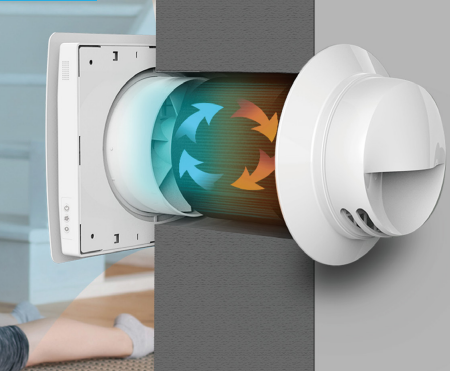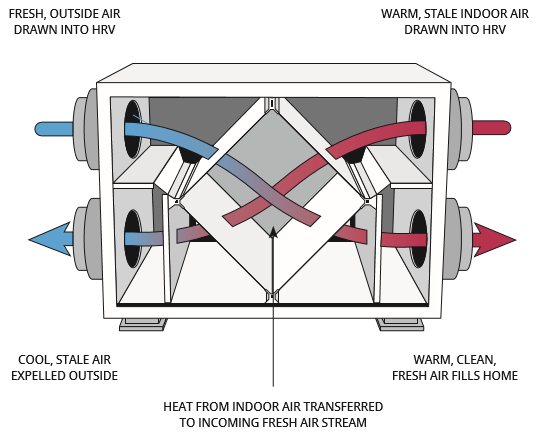How HRV Reduces Energy Bills Every Month
Wiki Article
The All-Inclusive Overview to the Uses of Heat Recovery Ventilation in Modern Structures
Heat Recovery Ventilation (HRV) systems stand for a considerable innovation in constructing modern technology (HRV Heat Recovery Ventilation). They provide an approach for trading stagnant interior air with fresh outdoor air while lessening power loss. This approach not only improves indoor air quality yet likewise adds to energy efficiency in both domestic and industrial structures. Comprehending the different applications and advantages of HRV can disclose its critical function in contemporary design and sustainability initiatives. The ramifications of this modern technology are worth exploring additionallyComprehending Heat Recovery Ventilation Systems

Although lots of modern-day buildings focus on power efficiency, recognizing warmth recovery air flow (HRV) systems is crucial for enhancing interior air high quality and reducing energy intake. HRV systems function by transferring warm from stagnant indoor air to incoming fresh air, properly preserving comfortable indoor temperatures while reducing energy loss. These systems consist of a heat exchanger, followers, and ductwork that promote the blood circulation of air. During winter, HRV units capture and reuse heat from the outgoing air, while in summer, they can help cool down inbound air. By constantly trading air, HRV systems likewise lower humidity and the concentration of indoor contaminants. Appropriate installment and upkeep of HRV systems are crucial for their efficiency and effectiveness in enhancing overall structure performance and comfort.
Benefits of Heat Recovery Ventilation
Heat recovery ventilation systems use numerous advantages that boost both power efficiency and interior air high quality in contemporary buildings. By catching and reusing power from exhaust air, these systems substantially reduce cooling and heating expenses, resulting in reduced power consumption. Additionally, they maintain a constant flow of fresh exterior air, decreasing the threat of indoor air pollutants and allergens. This constant exchange helps control moisture levels, stopping mold and mildew development and ensuring a much healthier living atmosphere. In addition, HRV systems contribute to sustainability goals by decreasing overall carbon impacts. Their ability to maximize air flow without compromising thermal convenience makes them an important enhancement to modern structure design, promoting both financial and environmental benefits.Applications of HRV in Residential Structures
As homeowners significantly prioritize energy efficiency and indoor air quality, the applications of warm healing ventilation (HRV) systems in residential buildings have become extra prevalent. HRV systems are particularly helpful in snugly secured homes, where keeping fresh air blood circulation is vital for preventing wetness accumulation and interior toxins. They properly move heat from outward bound stale air to inbound fresh air, lowering energy prices related to heating & cooling. In addition, HRVs can improve comfort degrees by controling humidity and temperature. They are also versatile for various household layouts, including single-family homes and multi-unit buildings. Generally, incorporating HRV systems sustains lasting living methods while ensuring a healthier interior setting for owners.HRV in Business and Industrial Setups
In industrial and commercial settings, the application of warmth recuperation ventilation (HRV) systems has actually come to be significantly crucial for maximizing power efficiency and maintaining air quality. These systems properly transfer heat from exhaust air to incoming fresh air, reducing the demand for additional home heating or air conditioning. This not only decreases energy expenses but additionally adds to sustainability efforts. Industries such as manufacturing, warehousing, and workplace structures benefit considerably from HRV systems, as they assist manage temperature and humidity degrees, making certain a comfortable and efficient setting. HRV systems aid in getting rid of pollutants and excess moisture, boosting interior air top quality. As policies around air top quality come to be stricter, the fostering of HRV modern technology is likely to expand, making it a critical component of modern-day business and commercial facilities.Future Fads in Heat Recovery Ventilation Modern Technology

Regularly Asked Questions
How Does Heat Recovery Ventilation Influence Indoor Air Quality?
Heat recovery ventilation greatly improves indoor air top quality by continuously exchanging stagnant indoor air with fresh outdoor air while recouping power. This procedure minimizes contaminants, maintains perfect moisture levels, and ensures a much healthier setting for occupants.Can HRV Systems Be Set Up in Existing Structures?
HRV systems can undoubtedly be installed in existing buildings. Retrofitting might require modifications to ductwork and air flow layouts, but it substantially improves power performance and interior air quality, making it a practical alternative for older frameworks.What Maintenance Is Needed for HRV Systems?

Are There Certain Climates Where HRV Is A Lot More Effective?
Heat recovery ventilation systems are particularly efficient in climates with significant temperature level differences in between seasons. These systems maximize energy effectiveness by recovering warmth from exhaust air, making them suitable for both chilly and reasonably warm environments.Exactly How Do HRV Equipments Affect Power Costs?

Report this wiki page